I’d been hearing about Michigan’s glowing Yooperlite rocks for years — but it wasn’t until this summer that we finally made it to the Upper Peninsula to try and find them ourselves. Even as someone who’s not a rock collector, I have to say: these rocks are very cool.
Yooperlites are ordinary-looking gray rocks that glow a fiery orange under UV light, and searching for them turned out to be one of our favorite family-friendly Michigan adventures. As a Michigan-based travel blogger, I love finding unique, low-cost experiences like this that kids and adults can both enjoy.
In this guide, I’ll share exactly where to go, what gear you need, and how to spot them — even if you’re a total beginner.
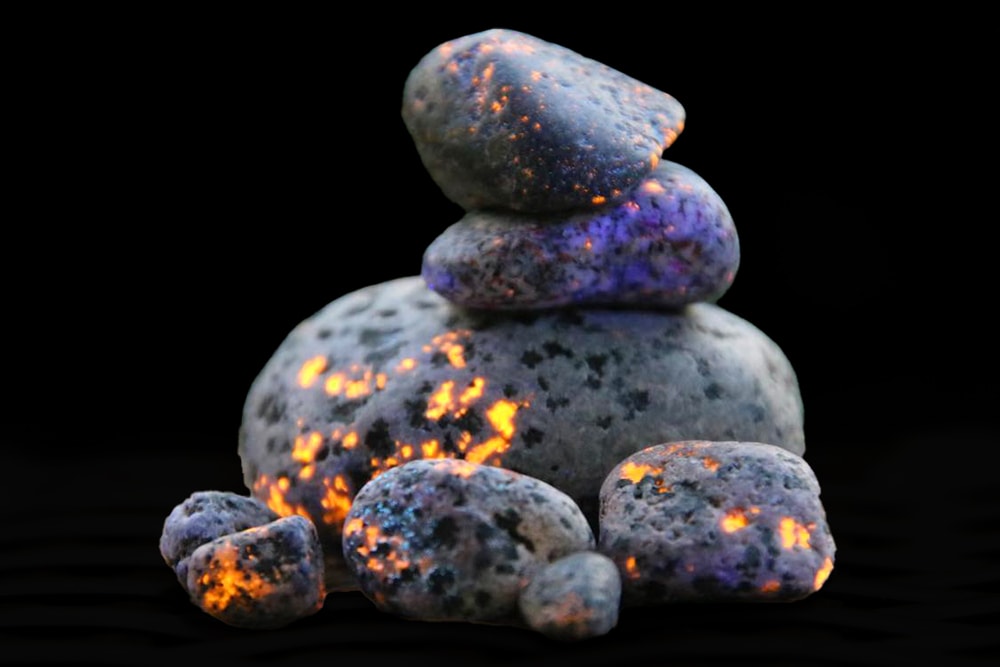
In a hurry? Here is the short version:
Yooperlites are glowing rocks found along Lake Superior beaches in Michigan’s Upper Peninsula. With a UV flashlight and a little patience, they’re easy to find — making them a fun, free adventure for all ages.
Quick Guide To Yooperlites
| Detail | Info |
|---|---|
| What Are They? | Gray syenite rocks with fluorescent sodalite that glows bright orange under UV light. |
| Best Yooperlite Beach Locations (Michigan) | Grand Marais, Keweenaw Peninsula, Sault Ste. Marie, Copper Harbor |
| Best Time of Year to Hunt Yooperlites | Spring and fall are best. Summer can work too. Avoid winter. |
| What You’ll Need | UV flashlight, clothing layers, closed-toe shoes, collection bag |
| Is It Good for Kids? | Yes — Yooperlite hunting with kids is safe, fun, and screen-free! |
What are Yooperlites?
Yooperlites are gray rocks that contain fluorescent sodalite — a mineral that glows bright orange under UV light.
They are a type of syenite rock, and while they look ordinary during the day, they light up like embers at night with the right UV flashlight.
The name “Yooperlite” comes from “Yooper” (nickname for residents of Michigan’s Upper Peninsula) and “lite” referring to the glow.
Eric Rintamaki (a local rock hunter) pushed to have the orange mineral scientifically verified. It became verified in May of 2018. He also gave the glowing rocks their name. You can even book guided Yooperlite tours in Michigan with Erik here.
Map Of Where to Find Yooperlite Rocks?
You’ll find the highest concentration of Yooperlites along the Lake Superior shoreline in Michigan’s Upper Peninsula. While they’ve also been spotted near Chicago and in parts of Minnesota, Michigan is where it all started — and still one of the best places to find them.
Top Yooperlite Beach Locations in Michigan:
- Grand Marais – Our personal favorite (we found 16!)
- Whitefish Point – No collecting allowed here
- Keweenaw Peninsula
- Sault Ste. Marie
- Copper Harbor
Tip: If you’re near a rocky beach, bring your UV flashlight. You might spot some by accident.
Is it legal to collect Yooperlite rocks?
According to Michigan, you’re allowed to collect:
- Up to 25 pounds of rock per person per year from public land
- No collecting from National Parks, National Lakeshores, or Whitefish Point
Please be mindful of private property & rules and regulations. Look them up for your specific destination before you hunt for Yooperlites.
Best Time Of Year To Find Yooperlites
Spring and fall are generally the best seasons to hunt for Yooperlites — but you can still find them in summer too. Here’s what you should know about each season.
Spring
As the snow starts to melt along Lake Superior, rocks that have been buried all winter begin to resurface. This means you’re often looking at stones that haven’t been picked over yet. Spring also tends to be quieter at the beaches, especially during the week, so you may have more of the shoreline to yourself.
Fall
Fall is another good time to go. Windier weather and wave action can shift rocks around and bring new ones up onto the shore. We’ve found that early to mid-October works well — just bring layers. It gets cold quickly once the sun goes down, especially along the water.
Summer
We went in mid-July and had no trouble finding Yooperlites. It’s a popular time to visit, so you may see more people out looking, especially near well-known beaches. You might need a little more patience as the rocks have been picked over — but it’s still a great time to go if you’re in the area.
Winter
Winter isn’t ideal for Yooperlite hunting.
The rocks are usually covered in snow or locked in ice, which makes it hard (or impossible) to see what’s glowing. Even if you bring a good flashlight, most of the shoreline is frozen over or not safely accessible.
If you’re visiting the U.P. in winter, here are a few things to do instead.
How to Find Yooperlites
Hunting Yooperlites is easy once you know what to look for. Here’s how we did it — and what we’d recommend to anyone trying it for the first time.
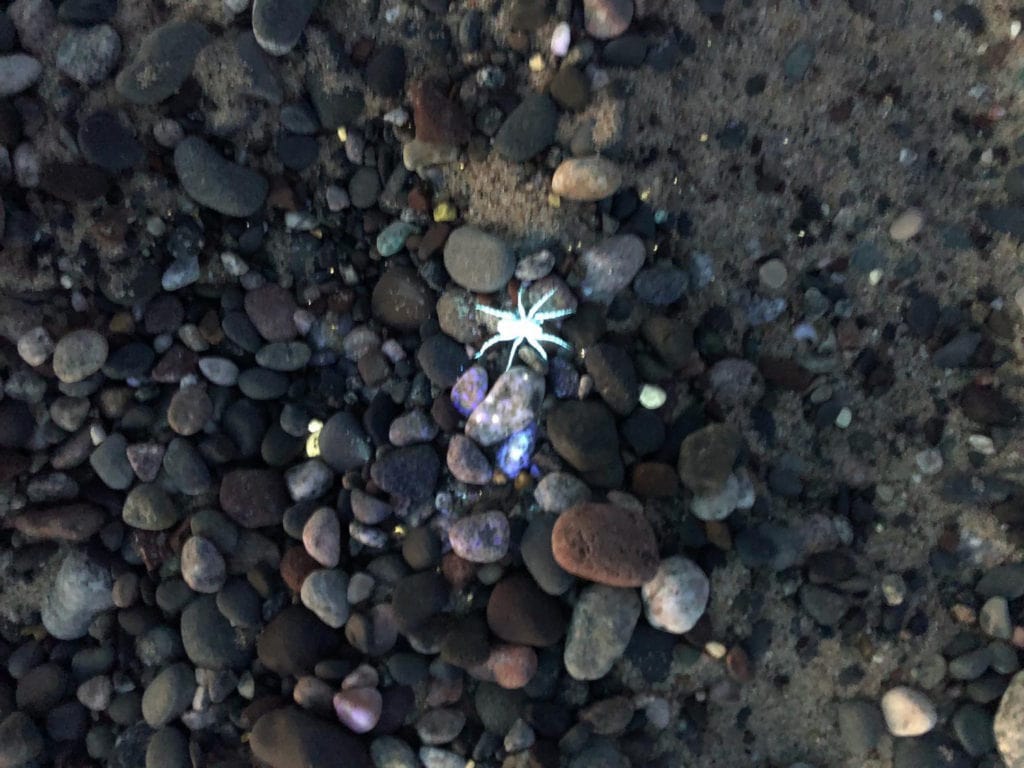
Get there before sunset
It’s important to arrive while it’s still light out. Once it’s dark, finding your way around — or back to your car — is a lot harder if you’re not familiar with the beach.
We got to Grand Marais about 30 minutes before sunset. That gave us time to get our bearings and enjoy the view before pulling out the flashlights.
Use a UV flashlight and go slow
We held our UV light just ahead of our feet and walked slowly across the beach. The best technique for us was walking in a straight line, then when we’d head back we’d walk the path next to the one we just walked. Walking in a pattern helped us avoid retracing the same ground.
Expect everything to glow at first
It’s wild how much lights up under UV — plastic bits, spiders, beach glass, minerals. At first, we picked up every glowing rock we saw because we weren’t sure what was what. But once we spotted our first Yooperlite, we knew instantly.
What does a real Yooperlite look like?
They glow bright orange, like tiny embers from a fire. Most are small, and they tend to have a speckled glow that stands out once you know what to look for.
Some of the fakes glow evenly all over — those are often glass or other materials. Yooperlites glow in patterns.
Recheck areas you’ve already walked
More than once, we found Yooperlites in spots we thought we’d already searched. Sometimes you miss one, or it catches light differently depending on your angle.
Don’t forget to check the water
Yes, UV lights can find Yooperlites in shallow water. Waterproof shoes or boots help if you plan to scan along the shoreline.

What do Yooperlites Look Like in Daylight?
Unfortunately, during daylight and to the naked eye, Yooperlite rocks look like every other rock along the shores of Lake Superior. This is why it is so important to use a black light UV flashlight to hunt for them. That being said, most of our Yooperlites look like gray rocks when they are not under a black light.
Can Yooperlites be found During the Day?
Yes, Yooperlites can be found during the day. If you are planning on looking for Yooperlite rocks during the day, I highly recommend using a very high-powered black light flashlight. Keep in mind that the more daylight there is the fainter the Yooperlites will glow.
Are Yooperlites Rare?
I wouldn’t consider them rare when looking along the Lake Superior shoreline. We went hunting for Yooperlites in the middle of summer when the beaches should have been well picked over and we found quite a few in a couple of hours. There were also a couple of other families searching for Yooperlites and they also found some.
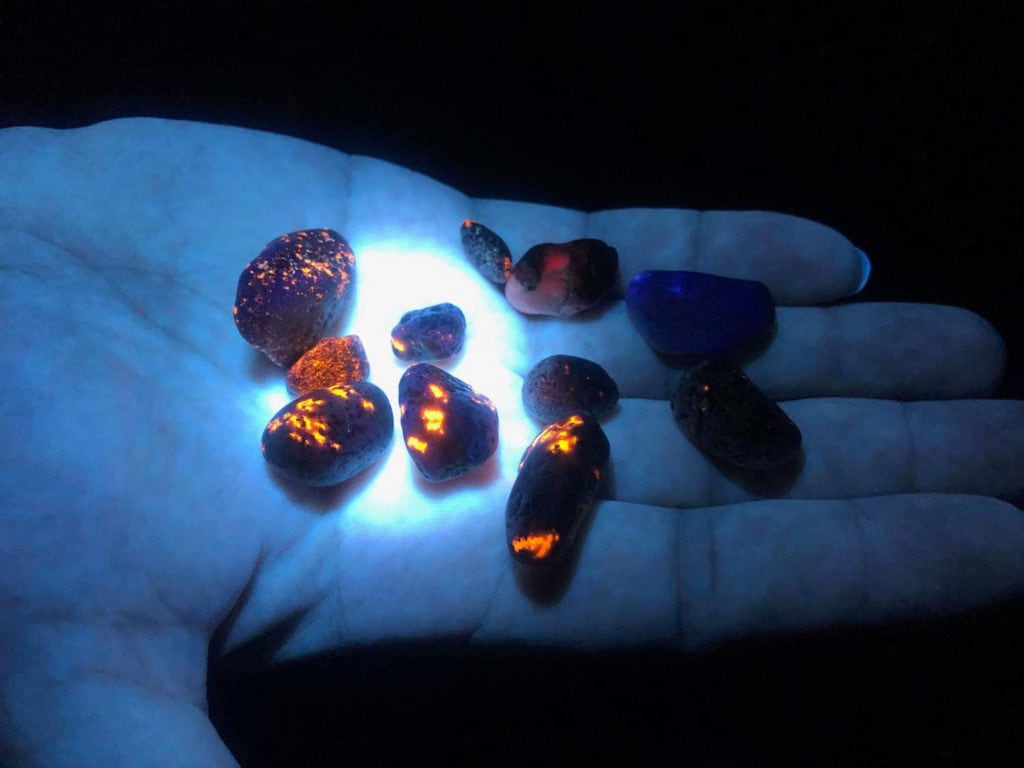
What To Bring Yooperlite Hunting
What Blacklight UV Flashlight Should I use to Find Yooperlite Rocks
There are so many UV Lights to choose from that choosing one can be overwhelming. We were so thankful that we stumbled across the video below because they were so helpful in breaking everything down in an easy and understandable way. We chose to use this UV flashlight after hearing their recommendations. It was exactly as they described it and worked beautifully. I highly encourage you to watch the video below and then choose the UV flashlight that works best for you. Whatever flashlight that you choose, make sure that it is a 365-nanometer UV flashlight. The rocks glow best under this wavelength.
Final Thoughts On Yooperlite Hunting
This turned out to be one of the most fun and affordable family adventures we’ve done in Michigan. It’s screen-free, budget-friendly, and just the right mix of relaxing and exciting.
Whether you’re traveling with kids, on a date night, or just looking for something unique, Yooperlite hunting in Michigan’s Upper Peninsula is absolutely worth adding to your list. As long as you’re comfortable walking on uneven, rocky beaches, this is a great adventure for kids, parents, and even grandparents.
While you are rock hunting, keep your eyes peeled for Lake Superior agates & other types of fluorescent minerals. Oh, and don’t forget to look up every once in a while. You’ll see an incredible starry sky, and you might even spot the milky way or northern lights.
Have you searched for Yooperlite rocks before? Let us know in the comments!
Don’t forget to pin this post or share it with someone planning a family trip to Michigan.
Looking for more things to do in Michigan?
Michigan’s Upper Peninsula in Winter
Things to do in Michigan This Fall
Where to see Northern Lights in Michigan
FAQ About Yooperlite Rocks
What’s the best UV flashlight for finding Yooperlites?
You’ll want a 365nm UV flashlight. We used this one and it worked great. Avoid cheap purple lights — they don’t give the same effect. The Yooperlites don’t glow as well.
Do Yooperlites glow forever?
Yes! They’ll glow every time you shine a proper UV light on them. The effect doesn’t wear out.
Are Yooperlites dangerous or toxic?
Nope. They’re just regular rocks with a glowing mineral inside. Yooperlites are not toxic and are completely safe to handle.
About the Author
Melissa is the voice behind Hello Wanderlust Family — a Michigan-based travel blog that helps families find fun, affordable, and unforgettable adventures across the U.S. From road trips to hidden gems like Yooperlite rocks, she shares firsthand tips, gear guides, and honest reviews to make planning easier.
Reader’s
top purchases of
2024!
Pin Now, Travel Later
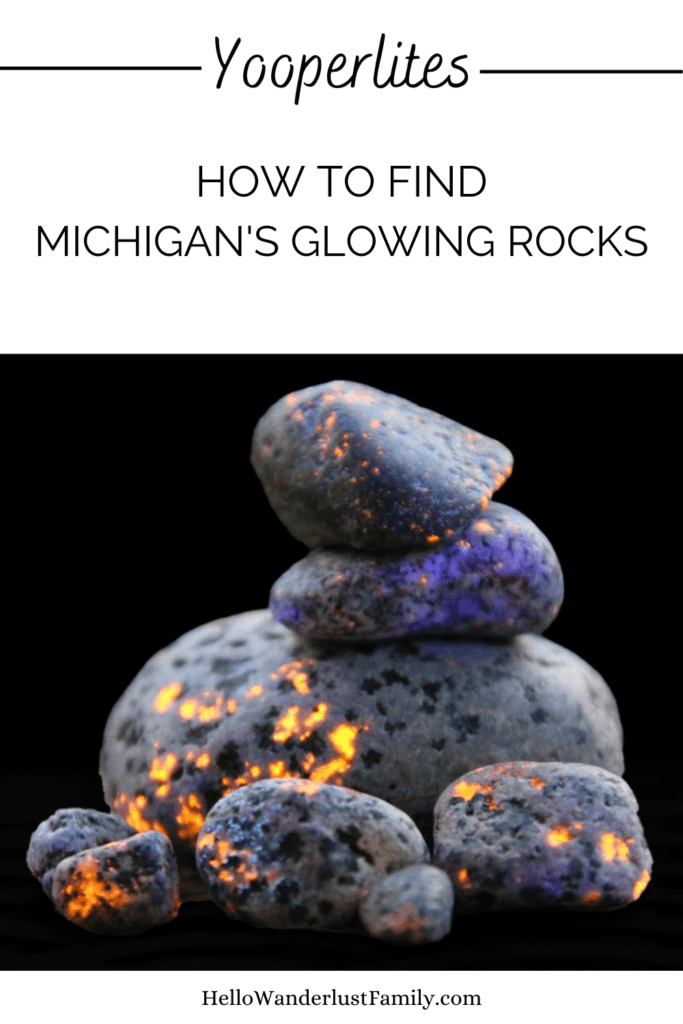
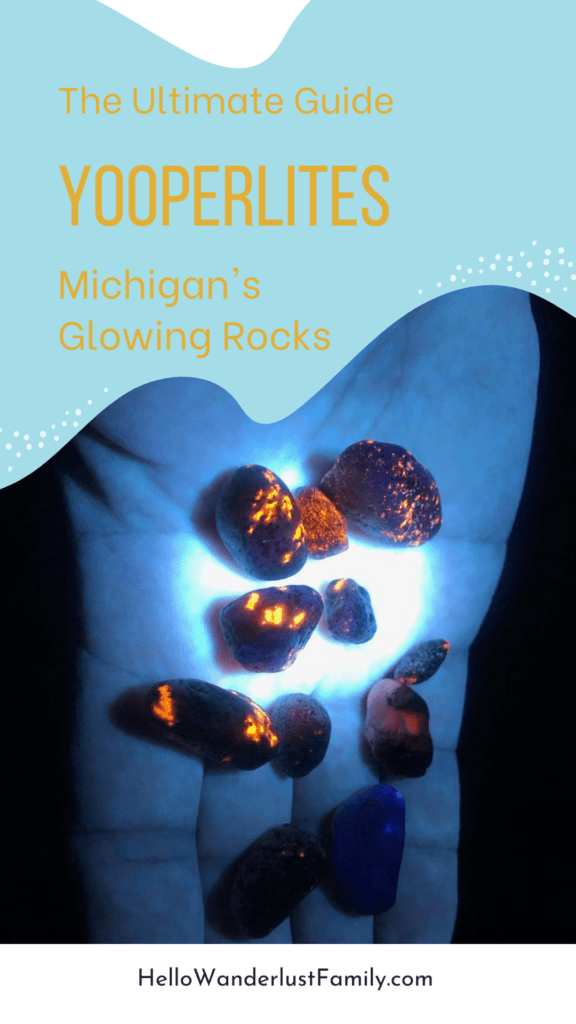
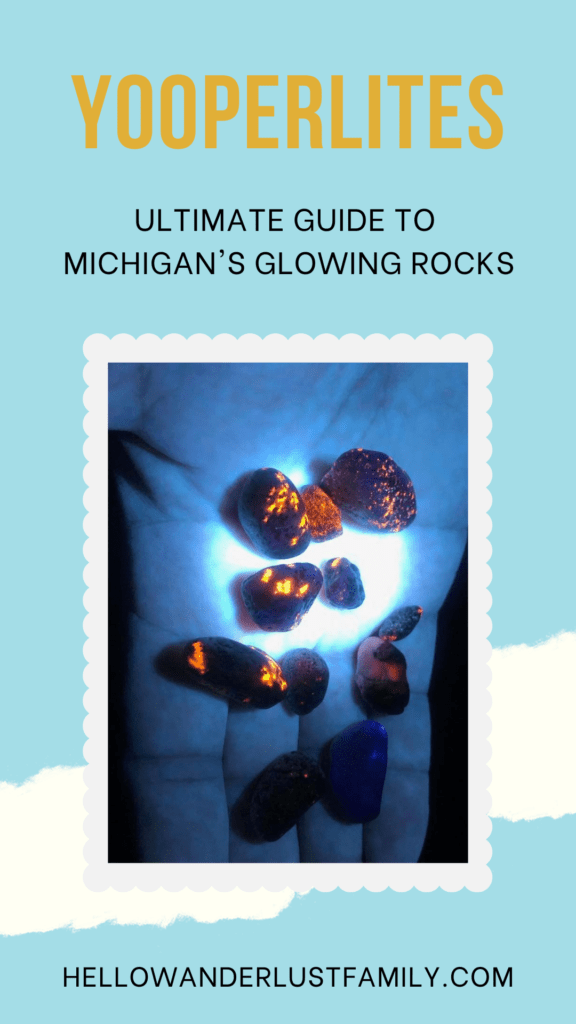

Greetings. My name is Shawn Carlson, and I am the mineralogist who identified what Erik Rintamaki’s rocks were, and published that finding in the journal Mineral News. Here is the link to my paper on Mr. Rintamaki’s main sales page:
https://www.yooperlites.com/img/Yooperlite_Sodalite_Discovery_Paper.pdf
Your article gets a couple things wrong. First, Michigan State (University) had absolutely nothing to do with the analysis of these rocks. And second, Mr. Rintamaki was not actually the first person to discover them. In fact, they had been known in Michigan and even sold in some gift shops for decades before Mr. Rintamaki entered the picture. What Mr. Rintamaki did, is to push for a full scientific verification of what the orange glowing mineral was (sodalite). Prior to this time, sodalite had long been suspected or “known” in a lay sense to occur in Michigan, but never actually verified. After this verification, sodalite became a mineral officially listed in Michigan’s geographic mineralogy, and I had to give credit for that to someone, so I gave credit to Mr. Rintamaki.
Hope this helps,
Shawn M. Carlson
Mineralogist
Thank you for giving me a heads-up on my inaccuracies. You are right it was not MSU it was Michigan Tech. As for my paragraph about Eric Rintamaki discovering the Yooperlites, I have reworded it in hopes to remove any confusion. I appreciate you taking the time to read through my article and provide feedback. It is extremely valuable to have first-hand information from someone who identified what Erik Rintamaki’s rocks were.
I am thrilled to read this article about Erik Rintamaki and his discovery of Yooperlites. It’s amazing to see how a simple hobby of rock hunting can turn into a successful business venture. I can relate to Erik’s passion for finding unique rocks along Lake Superior’s shoreline, and his discovery of Yooperlites is truly remarkable. For those who are unfamiliar with Yooperlites, they are rocks that contain Sodalite from the Syenite family of minerals. What makes them unique is their ability to glow fluorescent orange under a black light. Since their discovery, Yooperlites have become quite popular among rock hunters and collectors. If you are interested in learning more about yooperlites and the best places to find them, I invite you to visit my website. As an avid Yooperlite hunter, I have compiled a wealth of information and resources that will help you get started on your own Yooperlite hunting adventure. Happy hunting!
I can’t believe you’re allowed to take 25 pounds of Yooperlites per person!Sounds like a lot!
25 pounds of rock per person per year is a lot! Between my family of 4, we only found a couple of rocks. Nowhere near 25 lbs.
Ok I’m obsessed! I never heard of them before and I’d love to see them at night!
I’ve never heard of Yooperlite rocks before. I would love to do a tour with Erik. I’m sure it will be so interesting and informative!
How cool. Seems like a fun family activity or even a great idea for a date night!
Wow I’m sad I didn’t know about this when I lived in Michigan! I’ve been itching to go to the UP anyway so guess I have to add this to my list of things to do
I have never heard of Yooperlite Rocks! Wow. They are so cool. Need to add this to the list of places to visit and things to search for on hikes. Thank you so much for sharing. My kiddos would love these.
Wow! That is so very interesting and I had no idea about these rocks! Thank you for sharing!